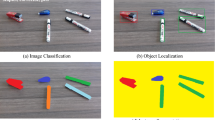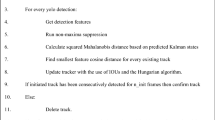Abstract
Unsupervised person re-identification (Re-ID) is a challenging task due to the problems of the view-specific gap across different cameras and the missing of ground truth labels. The intra-class variance caused by the camera domain gap makes the model difficult to distinguish cross-view discriminative information. The noisy pseudo labels may be misguide the model toward deteriorated over-fitting. Improving the clustering accuracy of pseudo labels and alleviating the intra-class variance can improve the performance of unsupervised person Re-ID. Most methods improve clustering accuracy by optimizing the clustering distribution of instance features in the memory bank. However, the optimized distribution is still unbalanced and has a large intra-class gap. In order to address this problem, we propose a camera-aware progressive learning (CAPL) for unsupervised person re-identification. In CAPL, on the one hand, clustering edge features are explored and used to update all instance features belonging to the same pseudo label in the memory bank, which makes the instance feature distribution more balanced; on the other hand, camera-relevant features are explored to update all instance features with the same pseudo-labels in the memory bank as well as the corresponding camera class centroids, which makes the model effectively reduces the intra-class variance. This process is performed iteratively, and finally, the global clustering distribution can be achieved progressively. Extensive experiments on four person Re-ID benchmarks and a vehicle Re-ID benchmark demonstrate that our proposed approach outperforms the state-of-the-art methods in terms of mAP and CMC.








Similar content being viewed by others
Data availability
The datasets generated during and/or analyzed during the current study are available from the corresponding author on reasonable request.
References
Deng W, Zheng L, Ye Q, et al (2018) Image-image domain adaptation with preserved self-similarity and domain-dissimilarity for person re-identification. In: CVPR, pp 994–1003
Yang F, Zhong Z, Luo Z et al (2020) Leveraging virtual and real person for unsupervised person re-identification. IEEE Trans Multimedia 22(9):2444–2453
Ning X, Gong K, Li W et al (2021) Feature refinement and filter network for person re-identification. IEEE Trans Circuits Syst Video Technol 31(9):3391–3402
Yan C, Pang G, Bai X et al (2022) Beyond triplet loss: person re-identification with fine-grained difference-aware pairwise loss. IEEE Trans Multimed 24:1665–1677
Lin Y, Dong X, Zheng L, et al (2019) A bottom-up clustering approach to unsupervised person re-identification. In: AAAI, pp 8738–8745
Wang D, Zhang S (2020) Unsupervised person re-identification via multi-label classification. In: CVPR, pp 10,978–10,987
Zeng K, Ning M, Wang Y, et al (2020) Hierarchical clustering with hard-batch triplet loss for person re-identification. In: CVPR, pp 13,654–13,662
Li YJ, Lin CS, Lin YB, et al (2019) Cross-dataset person re-identification via unsupervised pose disentanglement and adaptation. In: ICCV, pp 7918–7928
Ji Z, Zou X, Lin X, et al (2020) An attention-driven two-stage clustering method for unsupervised person re-identification. In: ECCV, pp 20–36
Fu Y, Wei Y, Wang G, et al (2019) Self-similarity grouping: a simple unsupervised cross domain adaptation approach for person re-identification. In: ICCV, pp 6111–6120
Wei L, Zhang S, Gao W, et al (2018) Person transfer gan to bridge domain gap for person re-identification. In: CVPR, pp 79–88
Li D, Li D, Zhang Z, et al (2019) Unsupervised cross-domain person re-identification: a new framework. In: ICIP, pp 1222–1226
Zhou S, Wang Y, Zhang F et al (2021) Cross-view similarity exploration for unsupervised cross-domain person re-identification. Neural Comput Appl 9(33):4001–4011
Zhang W, Huang L, Wei Z et al (2021) Angular regularization for unsupervised domain adaption on person re-identification. Neural Comput Appl 24(33):17041–17056
Yang F, Zhong Z, Luo Z, et al (2021) Joint noise-tolerant learning and meta camera shift adaptation for unsupervised person re-identification. In: CVPR, pp 4853–4862
Xuan S, Zhang S (2021) Intra-inter camera similarity for unsupervised person re-identification. In: CVPR, pp 11,921–11,930
Hadsell R, Chopra S, LeCun Y (2006) Dimensionality reduction by learning an invariant mapping. In: CVPR, pp 1735–1742
Wu Z, Xiong Y, Yu SX, et al (2018) Unsupervised feature learning via non-parametric instance discrimination. In: CVPR, pp 3733–3742
Ge Y, Zhu F, Chen D, et al (2020) Self-paced contrastive learning with hybrid memory for domain adaptive object re-id. In: NeurIPS, pp 11,309–11,321
Shu X, Yuan D, Liu Q et al (2020) Adaptive weight part-based convolutional network for person re-identification. Multimed Tools Appl 79(31):23617–23632
Zhong Z, Zheng L, Luo Z, et al (2019) Invariance matters: exemplar memory for domain adaptive person re-identification. In: CVPR, pp 598–607
Yu HX, Zheng WS (2020) Weakly supervised discriminative feature learning with state information for person identification. In: CVPR, pp 5527–5537
Qi L, Wang L, Huo J, et al (2019) A novel unsupervised camera-aware domain adaptation framework for person re-identification. In: ICCV, pp 8079–8088
Zhang X, Cao J, Shen C, et al (2019) Self-training with progressive augmentation for unsupervised cross-domain person re-identification. In: ICCV, pp 8221–8230
Lin Y, Xie L, Wu Y, et al (2020) Unsupervised person re-identification via softened similarity learning. In: CVPR, pp 3387–3396
Yin Q, Wang G, Ding G et al (2021) Multi-view label prediction for unsupervised learning person re-identification. IEEE Signal Process Lett 28:1390–1394
Lu J, He Y, Liu T et al (2019) Centralized and clustered features for person re-identification. IEEE Signal Process Lett 26(6):933–937
Zhong Z, Zheng L, Li S, et al (2018) Generalizing a person retrieval model hetero- and homogeneously. In: ECCV, pp 176–192
Yang Q, Yu HX, Wu A, et al (2019) Patch-based discriminative feature learning for unsupervised person re-identification. In: CVPR, pp 3628–3637
Jin X, Lan C, Zeng W, et al (2020) Global distance-distributions separation for unsupervised person re-identification. In: ECCV, pp 735–751
Wang M, Lai B, Huang J, et al (2021) Camera-aware proxies for unsupervised person re-identification. In: AAAI
He K, Fan H, Wu Y, et al (2020) Momentum contrast for unsupervised visual representation learning. In: CVPR, pp 9726–9735
He K, Zhang X, Ren S, et al (2016) Deep residual learning for image recognition. In: CVPR, pp 770–778
Ester M, Kriegel HP, Sander J, et al (1996) A density-based algorithm for discovering clusters in large spatial databases with noise. In: KDD, pp 226–231
Zheng L, Shen L, Tian L, et al (2015) Scalable person re-identification: a benchmark. In: ICCV, pp 1116–1124
Ristani E, Solera F, Zou R, et al (2016) Performance measures and a data set for multi-target, multi-camera tracking. In: ECCV, pp 17–35
Sun X, Zheng L (2019) Dissecting person re-identification from the viewpoint of viewpoint. In: 2019 IEEE/CVF conference on computer vision and pattern recognition (CVPR), pp 608–617
Liu X, Liu W, Mei T, et al (2016) A deep learning-based approach to progressive vehicle re-identification for urban surveillance. In: ECCV, pp 869–884
Liu X, Liu W, Mei T et al (2018) Provid: Progressive and multimodal vehicle reidentification for large-scale urban surveillance. IEEE Trans Multimed 20(3):645–658
Diederik PK, Jimmy B (2015) Adam: a method for stochastic optimization. In: ICLR
Zhong Z, Zheng L, Cao D, et al (2017) Re-ranking person re-identification with k-reciprocal encoding. In: CVPR, pp 3652–3661
Li J, Zhang S (2020) Joint visual and temporal consistency for unsupervised domain adaptive person re-identification. In: ECCV, pp 483–499
Ding Y, Fan H, Xu M et al (2020) Adaptive exploration for unsupervised person re-identification. ACM Trans Multimed Comput Commun Appl 16(1):1–19
Li M, Sun H, Lin C et al (2022) The devil in the tail: cluster consolidation plus cluster adaptive balancing loss for unsupervised person re-identification. Pattern Recogn 129(108):763
Yin J, Zhang S, Xie J et al (2022) Unsupervised person re-identification via simultaneous clustering and mask prediction. Pattern Recogn 126(108):568
van der Maaten L, Hinton G (2008) Viualizing data using t-SNE. J Mach Learn Res 9:2579–2605
Acknowledgments
This work is supported by the National Natural Science Foundation of China (61976034,U1808206), the Dalian Science and Technology Innovation Fund (2022JJ12GX013), the Liaoning Natural Science Foundation(2022-YGJC-20), and the Fundamental Research Funds for the Central Universities (DUT21YG106).
Author information
Authors and Affiliations
Corresponding author
Ethics declarations
Conflict of interest
The authors declare that they have no conflict of interest.
Additional information
Publisher's Note
Springer Nature remains neutral with regard to jurisdictional claims in published maps and institutional affiliations.
Rights and permissions
Springer Nature or its licensor (e.g. a society or other partner) holds exclusive rights to this article under a publishing agreement with the author(s) or other rightsholder(s); author self-archiving of the accepted manuscript version of this article is solely governed by the terms of such publishing agreement and applicable law.
About this article
Cite this article
Liu, Y., Ge, H., Sun, L. et al. Camera-aware progressive learning for unsupervised person re-identification. Neural Comput & Applic 35, 11359–11371 (2023). https://doi.org/10.1007/s00521-023-08301-w
Received:
Accepted:
Published:
Issue Date:
DOI: https://doi.org/10.1007/s00521-023-08301-w




